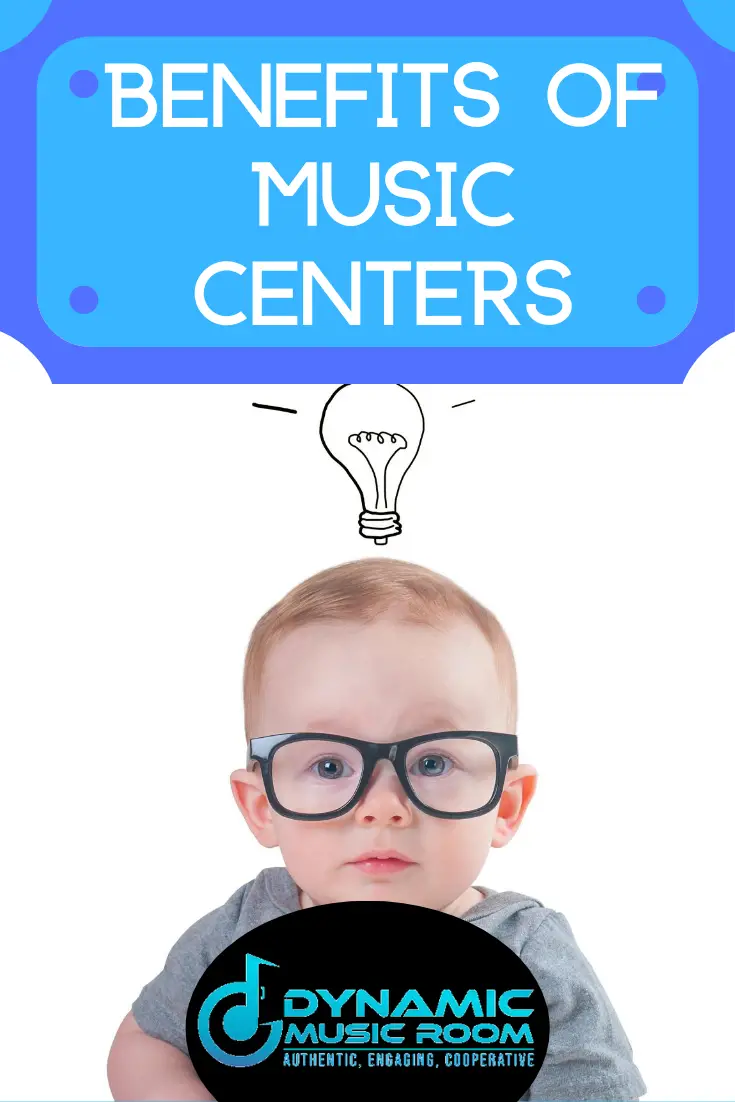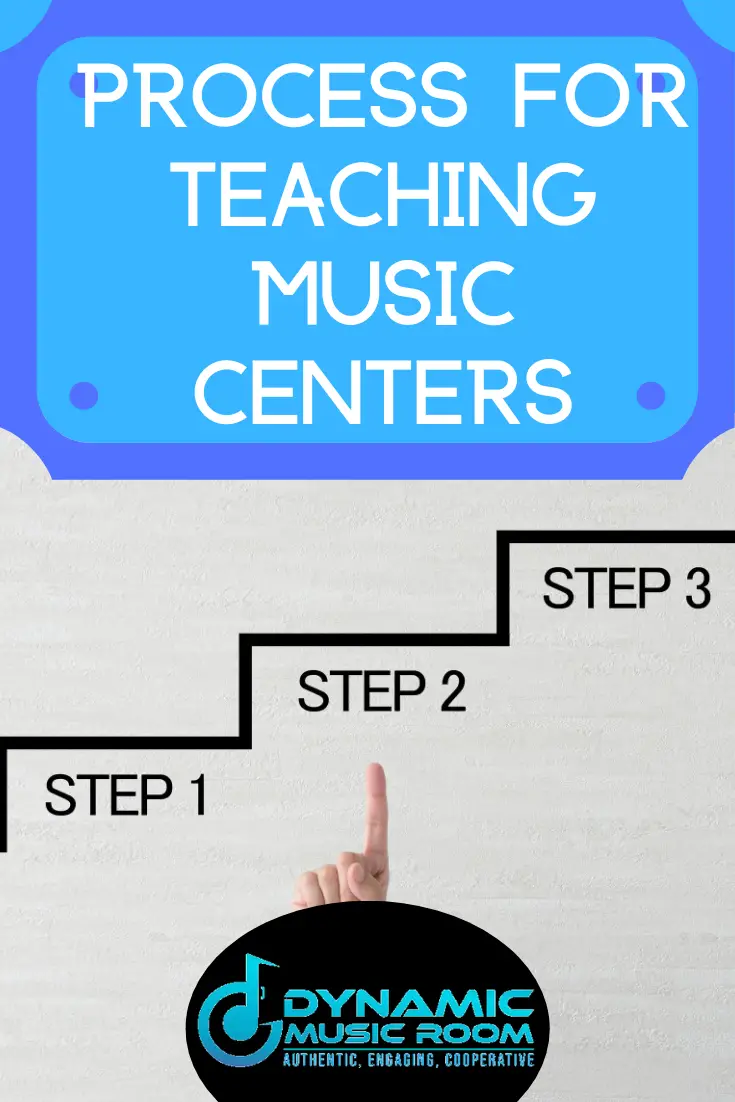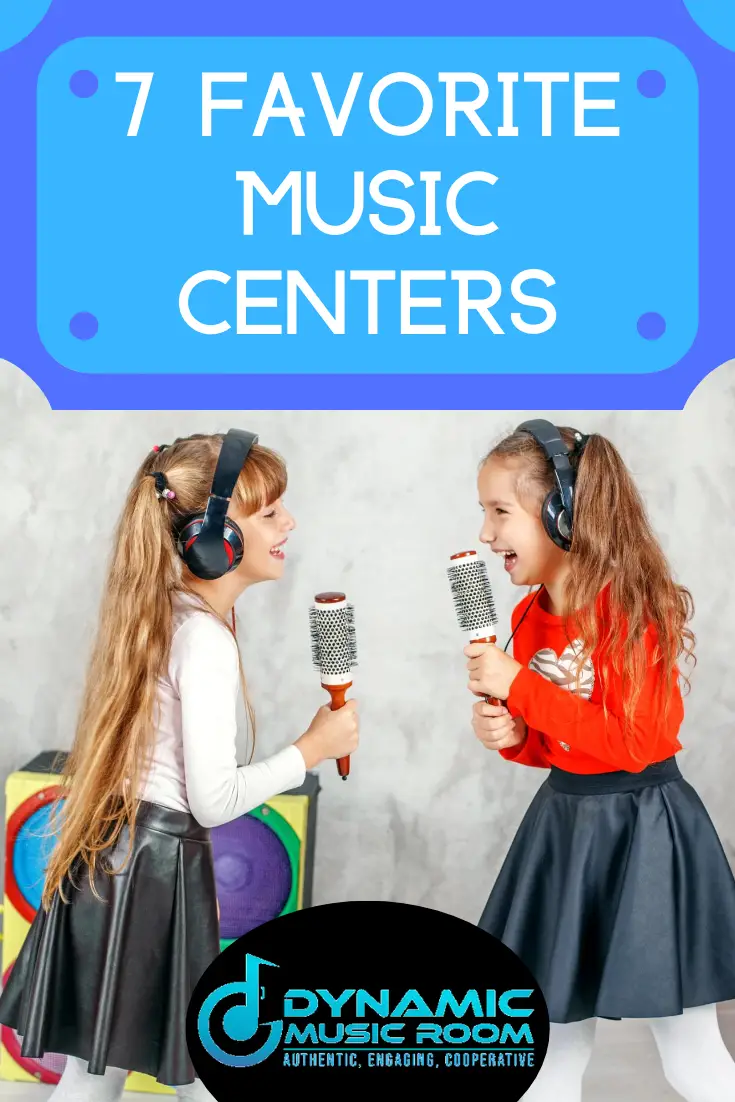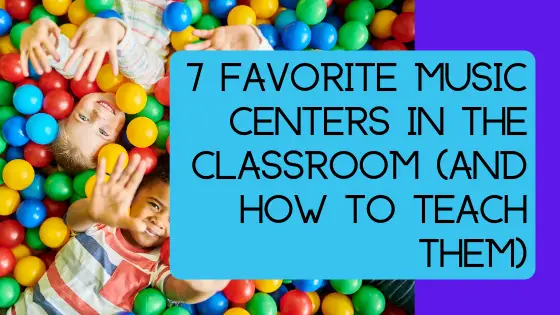Do you want to shake up your classroom?
Are you looking for ways to implement deeper learning and offer more specific feedback to smaller groups of students?
My administrator this past year was asking me what I wanted my professional goal to be, and I took the question seriously.
After all, not many admins will let you choose!
Looking at my teaching, I realized I’ve dabbled in center activities before with little success. I knew it was a good idea, but I had trouble seeing how to implement it.
So I made it my goal and buckled down to come up with a plan. Here is what I learned about music centers in the classroom.
Starting music centers in a classroom requires some planning, but being able to offer specific feedback and reach students where they’re at outweighs the efforts. It all starts by teaching the activities one at a time, then preparing them with the procedure, and finally implementing them with a watchful eye.
Look ahead for more details on what I learned.
Table of Contents
Benefits of Music Centers For The Students
Before we dig into these centers, you may be wondering why you shouldn’t even bother.
I thought this too for years, but when I looked into I realized the numerous benefits made it worth a shot.
Most of this information comes from Scholastic and their guide on learning centers.
Take Charge Of Their Learning
Sometimes we limit our children’s potential by telling them exactly what they’re supposed to do and guide them along every step of the way.
Never forget, the ultimate goal of any class, including music, is to develop independent students.
By being on their own (or in a small group) for centers, the kids must take charge.
They own the lessons and their work. In the end, this helps to motivate them.
More Exploration In Learning
Learning centers are more open to interpretation by the students.
Even when you give them a fun, simple game to play, by music’s nature every experience is slightly different.
I also encourage my students (after they’ve done the work as they’re supposed to) to create new twists on the activities.
Never underestimate the importance of problem-solving and exploration in learning.
Remove Fear Of Failure
While the fear of failure may never be truly gone, being in small groups reduces the fear greatly.
In class, some students are intimidated by the larger class and feel self-conscious.
No matter how nice and positive you are with your students, there will probably always be some who are scared of you.
It’s just part of being a person.
The chance to move away from you and the large group will help many students feel more comfortable with taking the chance. In the end, they’ll learn a ton!

Social Learning
Kids of all ages, but especially the older ones, need to learn how to work and interact with one another.
For older students, this peer-work is an essential part of how they feel safe learning.
Music centers and other types of cooperative learning are huge for this.
Unfortunately, it’s not simply a matter of putting kids in a group, and learning magically happens.
You have to teach them how to work together.
See the later sections on how to do this.
Develop Self-Discipline And Motivation
I bet we all know at least one adult like this:
The person is sharp, one of the smartest people we know, but they have no motivation. They float from job to job (or no job) and waste a huge potential.
Admittedly, I go through this “wasted potential” myself some days.
Self-discipline and self-motivation are key parts of being successful adults.
I tell my sons all the time: “Sometimes we have to do things we don’t want to, but they have to be done.
You must be able to get these things done.”
Learning centers are the perfect place to start with this.
Allow You To Give Specific Feedback
This is key for me. According to Visible Learning, the feedback has an effect size of 0.70 or almost two years of instruction.
Seeing over 700 students each week limit this strategy, but it’s important. Music centers in the classroom are key for getting this done more effectively.
Admin Loves It!
OK, this one’s a cop-out, but let’s be honest here.
We all want to get good evaluations. We all want our admin to think we’re geniuses.
They don’t understand the concepts we cover, but they know good teaching strategies.
Applying good teaching strategies from the gen ed world makes us look even better than we already do.
Sure, this is far down on my list of why I decided to add centers to my music room, but it’s still a part of it.
For related strategies, you may want to check out cooperative learning in the music classroom.

Process For Teaching Music Centers In The Classroom
The biggest hurdle I ran into when looking at music centers was how to go about teaching and running them effectively when I only see my students once per week for a short period.
After trying out different things and doing some research, here is the process I landed on.
#1 Teach each center as a whole group/small group activity
This is the step I missed the first time I attempted centers. And boy, what a big one to miss!
Maybe everyone is smarter than me (I wouldn’t be surprised), but I’d bet some other made this mistake as well.
I explained all the activities right before sending the kids off to do them.
It was way too much for them to handle. I know practical experience trumps explanations every time, but at the time, it completely left my head.
This time around, I taught each single center activity as its lesson. This happened throughout a few lessons.
Some of them, I modeled as a whole class activity. Others I broke into smaller groups closer to how the center would go when we got there.
#2 Teach procedures for centers
You must help the students learn how to work together. It’s not enough to expect them to know how to problem solve socially.
It’s not enough to invent procedures and attention-getters when they already started.
Plan it out and get it ready ahead of time.
Model what students should say to each other when there’s conflict. Have students pretend to talk it out.
It may seem fake (and it is), but you’re still giving them the vocabulary to fix the problems more on their own. This leaves you better able to monitor and help those in need.
Set up your attention getters before you start and practice them!
Give students steps to getting your attention. Forget this and they’ll just yell across the room to you.
#3 Make a plan
Decide who will be in each group. Plan it ahead of time, and avoid problems with students not getting along (mostly).
Decide how long you want students to spend at each center. I recommend 10-15 minutes to get them started.
With older students, they may be able to expand into longer periods.
This time frame may not work for your class time.
Don’t give up!
Plan on cycling through the centers over several classes instead of cramming it in a single lesson.
Make sure all materials are ready to go.
#4 Run the centers
With all the tools in place, start your centers! But your job isn’t done yet.
#5 Observe and manage the classroom
When everything seems like the students are running a class on their own, you’ll start to relax.
But now is the time for all the hard work to pay off, don’t relax!
Monitor the student for behavior issues, yes, but also step in and watch how kids are performing.
Being able to concentrate your attention on a few students each center and offer specific feedback. Pick a single center to focus on for this purpose.
Over time, you’ll reach all the students and give them ideas on how to improve.
Naturally, be ready to step in and fix behaviors or redirect the class with an attention getter and some feedback.
#6 Reflect and improve
You’re almost done.
Take notes after you’re done with centers on what went well and what didn’t. Brainstorm ideas on how to improve or reflect with other teachers.

7 Favorite Music Centers In The Classroom
This section covers 7 of my favorite music centers. I’ll include what information I can for you to implement these in your rooms easily.
The activities are adaptable to fit different grade levels and concepts.
Note: Some of these are useful as elementary music distance learning activities too.
#1 Building Rhythms
My kids love building rhythms. I start with rhythm flashcards appropriate for each grade and concept grouping.
I set these up at the start of the year and separate them into bins. Saves a lot of time.
During this station, students have two jobs they must do first before they can explore deeper.
- Read, clap, and say all the cards in their pack.
- Arrange at least 8 in a row and say them as one mega-rhythm.
After this, I open the rhythm cards up to them to explore and tweak how they see fit.
As a whole class when we learn this, I model a few of the following extensions:
- Alternate students saying rhythm cards one at a time
- Some students say all of one rhythm while others say another
- Memorize the longer rhythm by flipping over one rhythm at a time
- Use each card as an ostinato and play them together to make a cool groove (yes, with instruments)
- Say the rhythms in canon
- Perform the rhythms forwards and backward (and in canon with both at the same time)
#2 Reading Music Books
Not every music center needs to be high energy and focus on specific instruction. It’s good to switch it up for the kids.
I have a large selection of music books I enjoy reading and letting students read.
It doesn’t take much to encourage students to just look/read a book or books for a center. They probably already do this in their classroom.
Note: Make sure you have a wide variety of reading levels for these books. We all know how the reading level of our students varies greatly.
Check out 15 of my favorite music books with movement.
#3 IPads/Chromebooks
Some music teachers may think this is wimping out, but I completely disagree. Yes, music is best done actively, but it’s a waste of student-engagement-potential to deny how much they love learning from technology.
And to be honest, there are a lot of good programs out there that address music concepts.
Here are a few I recommend:
- Rhythm cat
- Piano tiles
- Flat.io (love these guys)
- Learn the orchestra
- Piano Dust Buster
- Monkey Drum
- Chrome Music Lab
- Garageband
- Loopimal
Pro-tip: Play some yourself and get a high score. Post it at the center and challenge your students to beat you.
#4 Busted!
This is a game my wife discovered on Pinterest somewhere. I don’t know who came up with it originally, but my kids love it.
If you’re the one that came up with it originally, reach out to me, and I’ll include your name in this section.
Essentially, you’ll need the following:
- A container such as an empty Clorox wipes container
- Thick popsicle sticks with rhythms on them
- Several of the sticks also say “Busted!”
Students take turns pulling the rhythm sticks and saying the rhythm. If they get it right they keep the popsicle stick. If not, they put it back.
When someone draws a Busted! Stick, they move all the sticks to the side. These are now out of the game.
Players take turns until all the sticks are gone. The winner has the most sticks.
It’s simple to set up and play.
I like to do this game with a twist. I use notecards with pitch patterns instead of rhythms.
Kids don’t get enough independent solfege practice in my opinion.
#5 Mystery Song
Take a song or songs the students know and print them off on separate cards measure by measure.
Mix up the cards.
The students need to figure out how to reassemble the songs in the correct order, guess the name of the song, and perform the rhythms and/or solfege of the tune.
Hints are provided on the back only if needed.
Once every song has been figured out, students can mix and match parts of songs to create a new song.
I recommend only doing songs they know well. Start with one or two songs to figure out in the pile of cards.
I wouldn’t go more than 4 different songs, but your older students may be able to handle it.
Pro-tip: This is a great one to do as a whole class too.
#6 Note Swatter
I’ve seen some versions of this game all from many different sources. This game is great for reinforcing note placement on the staff.
One person (the leader) calls out the note name. The others take a fly swatter and touch the correct spot on the staff.
If they get it right, they get a point.
Repeat until all cards are gone. Then, the leader switches out with another.
Repeat the whole game until everyone has had a turn.
Pro-tip: On the leader’s cards, show the note on the staff. This way, they know what the right placement is.
#7 Listening Station
If you have the ability, a listening station is a perfect center for engaging with classical music.
I’d stick to songs they already listened to and played with as the whole class.
I don’t get too fancy with this one. While they listen, I encourage them to draw anything.
I leave it pretty open.
You may wish to check out 9 classical songs to teach dynamics.
If you struggle with classical music resources, check out Maestro Classic. They have a ton of classical music-directed lessons my students find engaging at all age levels.
Tips For Teaching Music Centers In The Classroom
This is a lot to take in, but it’s all worth it once you get it going.
That being said, there are some tips I’ve discovered and picked up from others on the whole process I’d like to share.
These aren’t needed, but it’s still a good idea to implement as many of these as possible.
- Define the spaces from each center with signs.
- Keep the space spread out as much as possible.
- Display the timer for students to see.
- Be clear about the timing and the rotation plan.
- Make your attention getter visual rather than auditory (they may not hear you over the others as they do the centers).
- Keep groups down to 3-4.
- Pick students who get along well.
- The simpler the directions, the better they’ll go. Give challenging concepts, but easy directions.
- Vary the centers in energy level and difficulty.
- Don’t add new ideas or games to centers. Learning centers are for practicing known skills.
- Create rewards for best-performing groups.
If you have any other tips, let me know, and I’ll include it on the list!
Why Some Music Teacher Don’t Like Music Centers
There are legitimate reasons you may not want to introduce music centers.
I hold no judgment for those who don’t want to. It’s not required.
But allow me to respond to these concerns.
| Concern About Music Centers | Response |
|---|---|
| Too much work. | Yes, but once it’s planned out and gathered, the actual teaching becomes fairly hands-off. |
| Students won’t stay on task. | Some won’t, and you’ll have to redirect them. But if you practice the activities beforehand and set up expectations, most of them will stay on-task. |
| Students aren’t learning just by playing. | Um…isn’t music just playing by learning? You need to help them learn how to learn on their own through exploration. |
| You can’t teach music concepts this way. | You’re right! Learning centers are for practicing what they already know and exploring music; not learning new stuff. |
| I don’t have enough time. | Spread out your centers over various lessons. I know some teachers who spend only 10 minutes at the end of class on centers and rotate through them over weeks with success. |
| I have too many students. | I hear you. Maybe check out ways to reuse materials and organizational helpers. |
| I don’t have enough space. | Choose quieter activities and make the space small. Some use hula-hoops to limit the space. |
| I’m on a cart! | That’s hard. Strip down the materials as much as possible. Reach out to your teachers, they may already have center spaces used in their classroom. |
| There isn’t enough time in the year. | Fair enough, if you have other needs, don’t do it. Perhaps the centers could reinforce your other needs, though. |
These are just my answers to these comments. They aren’t meant to convince you to do centers but make you think a little more about them.
If you don’t do them at all, this doesn’t make you a bad teacher at all.
I’ve just enjoyed using music centers, though it did take work and creative thinking to get done.
Other Favorite Resources For Music Centers In The Classroom
If this is a lot, don’t worry; it is for everyone else too.
These are some resources and items that helped me along the way.
Check these out if you’d like.
First Steps In Music Book Series – All of these books are great song tales and picture books for reading/singing. Even older kids will enjoy this to a certain extent.
Dry Erase Pockets – I don’t know how I’d live without these.
They are clear pockets you use to insert papers and have students mark up with dry-erase markers.
Then you erase them for the next class.
No need to kill a rainforest for a single worksheet.
Classroom Keepers Mailbox – I get it. Dealing with materials for hundreds of students is a lot.
This affordable sorting mailbox helps me keep everything organized and ready to go for when I start centers.
Conversational Solfege Flashcards – Yeah, I could print off flashcards on my own (and have), but I’m lazy. Sometimes I just want to use something already made that suits my needs.
The conversational solfege flashcards are already sorted by concept including rhythm AND pitch.
I love these!
Staff Music Rug – At some schools, I project the staff for people to play the swatting game on.
But this rug is great for it too.
Plus, my younger students love to sit around it.
Final Thoughts
I hope this guide on how to run music centers in the classroom helps you.
It’s an involved process, but it’s one with many benefits at the end of the road.
I’m not saying all your teaching should involve centers, but doing them a few times per year is worth it.

